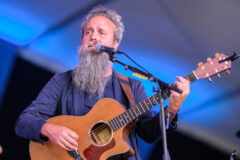For centuries, street singing was considered the lowest form of a musical career. Street musicians — buskers — were looked on as glorified beggars. But cities that once outlawed busking have come to embrace it — as a way to renew foot traffic in the age of Amazon.
While street singers used to depend on spare change, busking today is more sophisticated. Street and subway performers promote schedules and locations on social media, and accept Venmo. While interviewing buskers for my book, Down on the Corner: Adventures in Busking & Street Music, I learned how modern street performers have increased their commerce and respect.
Xavier Dphrepaulezz was signed to Interscope as a Prince-like R&B artist. When his 1993 album stiffed, he returned to Oakland where he played the streets. In stripping his music down to the basics, he discovered he wasn’t an R&B singer after all, but rather Fantastic Negrito, a folk-blues artist — and three-time Grammy winner for Best Contemporary Blues Album. “I didn’t want to chase fame and record deals anymore. I just didn’t care. I just wanted to connect on the streets with people coming home from work.”
Mary Lou Lord was more famous busking outside SXSW than when she was finally invited inside, to play an official showcase. She told her daughter, Annabelle, a second-generation busker: “Work smarter, not harder. So she plays outside major artists’ concerts. She told me, ‘Mom, you gotta get Venmo and a QR code. There’s bigger money now that people don’t carry cash anymore.’”
Billy Bragg says his busking origins taught him not to care whether there’s time for a soundcheck, even when playing a festival.
“You’re given a 15-minute changeover, you’ve got 12,000 people who want to hear you sing, so you just start playing. If the levels aren’t right, you just have to busk it. I hate being at festivals and watching artists spend 10 minutes getting the ball back. I’m like: The crowd is smiling. And that, to me, is busking. You deal with the environment, whatever it presents.


Leave a comment